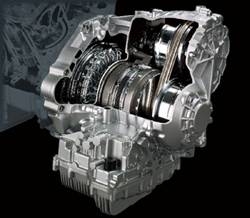
Transmissions started with manual gearboxes, then evolved to automatic transmissions, and the most recent technological advance is the continuously variable (CV) transmission. All automobiles need a transmission because 1) modern internal-combustion engines require a means to be disengaged from the drive wheels and idle when the automobile is temporarily stopped; and 2) a process to adjust the gear ratio linking the wheels and the crankshaft so a vehicle can obtain a high gear ratio when going up a hill at low speed level while carrying a heavy load or a low gear ratio when cruising with the engine at a moderate RPM level.
The concept of a CV transmission has been in development since the early 1900s. The CV transmission, unlike standard transmissions that only have a limited number of gear ratios, has an infinite number of probable gear ratios accessible in between a specific low gear ratio and a specific high gear ratio that are defined by the maximum and minimum diameter of the pulleys. This is an advantage over transmissions with fixed gear ratios, since the engine will always operate at the most efficient RPM, maximizing fuel efficiency and power delivered from the engine to the object being moved.
The continuously variable transmission design that is now primarily used is a basic design that has two pulleys attached to an elastic belt. The first pulley is attached to the engine, and the second one is attached to the drive axle. Each pulley is divided halfway and appears a bit like two cones pointed at each other. When the pulleys are stretched apart, the belt travels near the center of the two pulleys, and the transmission is in a high gear. As soon as the pulleys are pressed together, the belt moves back out, putting the transmission into a lower gear. Therefore, by altering the distance of the pulleys, the efficient diameter of the pulley changes as well, changing the gear ratio of the transmission to the engine without the abrupt changes and reduced efficiency that can be felt when operating a vehicle with a transmission that has fixed gear ratios. To allow the engine to be at rest when the drive axles are not moving, one or both of the pulleys can release, and the belt becomes loose and glides safely.

CV transmissions have been used for a a number of years in snowmobiles and in several models of low-powered automobiles. The reason that CV transmissions are not used in more automobiles is that the belts and chains normally used to transfer power between the pulleys can only withstand a limited amount of friction, but improvements to the materials used for the belt or chain, lubricants used and more intelligent electronic controls are sorting out these obstacles. Also, there is a concern that car buyers will be reluctant to select a automobile using this technology because of the noticeable change in the feel and sound of a CV transmission when compared to traditional transmissions.
Numerous low-powered automobiles have utilized CV transmissions for many years, and now improvements in the design of material technologies and elastic metal belt models used in these transmissions allow automobile manufactures to use them in vehicles with moderately sized engines. With manufacturers such as Nissan, Toyota, Audi, BMW and Ford using them in the design of their smaller cars, design improvements should continue.